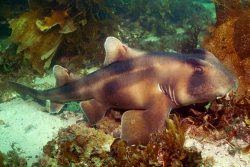select your film:


This species also known as The Crescent Bullhead Shark is an uncommon species of bullhead shark that belongs to the Heterodontidae family.
Biology:
The head of the crested shark is short and wide, with a blunt, pig-like snout. The eyes are placed high on the head. The nostrils are separated into incurrent and excurrent openings by a long flap of skin that reaches the mouth. The teeth at the front of the jaws are small and pointed with a central cusp and two lateral cusplets, while those at the back of the jaws are wide and molar-like. The pectoral fins are large and rounded, while the pelvic and anal fins are smaller and more angular apex and a stout spine on the leading margin. The second dorsal fin resembles the first and is almost as large, and is located between the pelvic and anal fins. The caudal fin is broad, with a strong ventral notch near the tip of the upper lobe. The dermal denticles are large and rough, especially on the flanks. The Crescent Bullhead Shark has various maximum sizes reported ranging from 120 cm to 165 cm TL. Females mature at about 70 cm TL and males at about 60 cm TL.
This species is oviparous, paired eggs are laid. Embryos feed solely on the yolk. Distinct pairing with embrace. Females produce 10 – 16 eggs per year during late winter in July and August, though Michael noted that egg-laying may continue year-round. Young is reported to hatch at about 22 cm TL.
Habitat:
The range of the Crested bullhead shark is restricted to the warm temperate water along the eastern coast of Australia, from Cape Moreton, Queensland, to Batemans Bay, New South Wales to a depth of 93 m. Also dubious records of the species from off Cape York Peninsula in the north and Tasmania in the south. This species is found around rocky reefs, among large macroalgae, and on seagrass beds.
Behavior:
The Crested Bullhead Shark is a slow-moving, nocturnal species often seen wedging its head between rocks in search of food. It feeds primarily on the sea urchins Centrostephanus rodgersii and Heliocidaris erythrogramma but has also been known to take a variety of other invertebrates and small fishes.
Conservation:
The Crested Bullhead Shark is likely to occur in a number of marine protected areas including Queensland’s Moreton Bay Marine Park at the northern extent of the species’ range, and several marine parks in New South Wales.
Do you have images or videos of Crescent Bullhead Sharks?
Submit them to [email protected].
